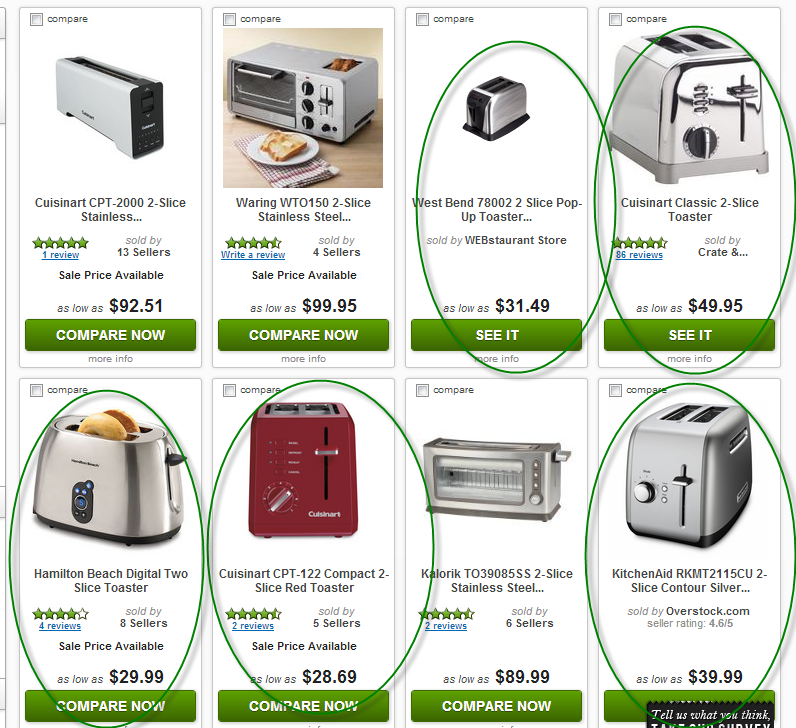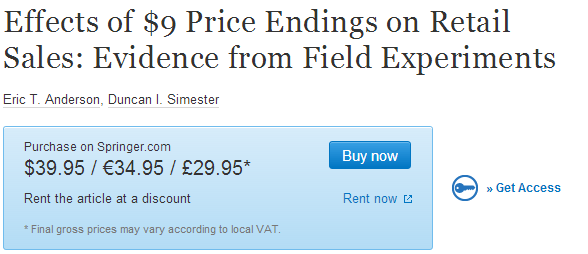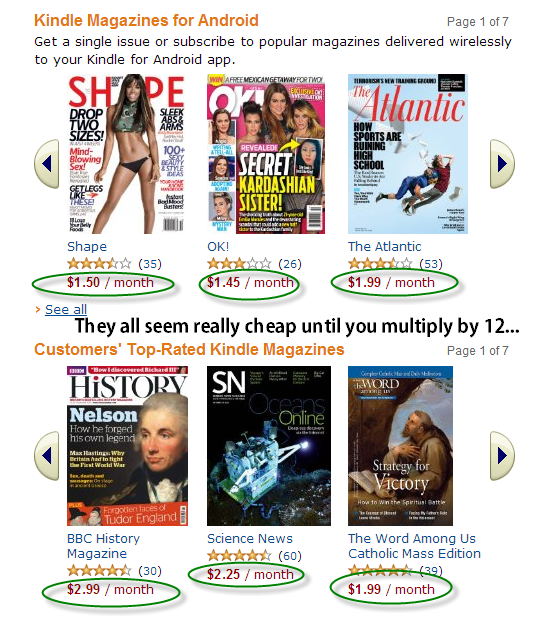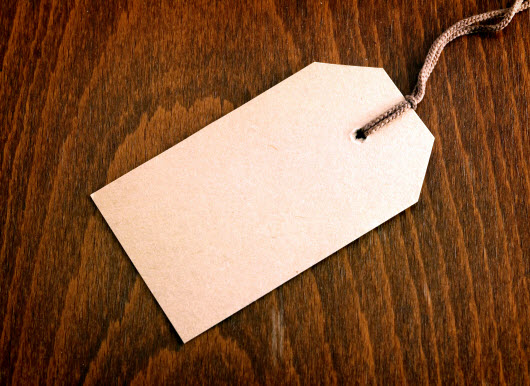5 Things to Consider when Setting Prices
One of the most important decisions that you will make as an Internet marketer is deciding what price to charge for your product or service. There is actually an entire field of science devoted to figuring out what the best price points are for a product and it’s not a simple matter. Most of us however, tend to just pick a number out of the air and hope for the best. Here’s how to do pricing the right way:
Don’t Get Into a Race to the Bottom
When was the last time you went out shopping for a pop up toaster? If you haven’t been in a while, drop by some stores and just take a moment to price them. You can even do it online. Be sure to compare apples to apples by looking only at standard two slice toasters. Don’t start looking at the four slice kind or the kind with special features.
Okay, done? What did you notice? If you’re like me, you might have noticed that name brands are priced a bit higher than off brands. However, you’ll also have noticed that the basic toasters pretty much all compete based on price. That’s because toasters are a commodity item. There’s really very little difference from one to the next and unless they have special features, there’s very little to distinguish one from the other.
In a quick comparison I did on PriceGrabber, all the basic two slice toasters (there are some other styles that got mixed into my search results but I’ve circled the ones that are relevant) are priced within around $20 of each other. Commodity items like a basic two slice toaster mostly compete based on price though you may seem some modest differences. For example, one of the toasters in my comparison is red which some people may like for their kitchen.

The thing is, if you can avoid it, you don’t want your product to be a commodity. You want your product to be something unique which will grab people’s attention and will get them to want your product, even if it costs more than the competition. Otherwise, you inevitably end up in a race to the bottom where you are always going to be outpriced by someone offering basically the same thing for a cheaper price.
Positioning Your Product
I recently started taking some graduate classes in a local university. Many of my new colleagues in my classes come to class with a laptop. In fact, on the first day of classes, we actually ended up with people jockeying for position to grab one of the wall outlets to charge their computers. That’s not what I want to bring up though.
It happens that the majority of my new colleagues are using Windows based PCs. One of them however, a retired MD (medical doctor) who is doing this program just because he’s interested in it, brought along a sleek MacBook Air. It gets the requisite oohs and ahs from anyone who knows anything about computers. It’s super thin and just looks great. It also happens to carry a really hefty price tag (I guess as a retired physician, he can afford the best).
My new colleague likely spent in the neighborhood of around $1,500-$2,000 for his computer. I recently bought myself a cheap laptop which cost me under $400. Now I’ll grant that the Air probably has a few more bells and whistles than my budget laptop. However, the thing that makes the Air so appealing is at least in part, the Apple brand name. It has cache.
Ideally, when pricing your product, you should think about who your potential market is going to be. Remember that going after the bargain seekers is often a bad idea. My own experience as a freelance writer has shown me that the people looking for super cheap writers are often the ones who are the worst customers.
As an example, one guy, who ostensibly is a very well off professor at another university, tried to hire me to ghostwrite a scholarly book for him and wanted to pay me $6 per page. I told him I’d never agree to such a low price but because I found his project interesting, I gave him a discount to the price I usually reserve for my best customers. Big mistake. The guy repeatedly complained and then refused to pay what he owes. The case is now pending in court.
Bottom line, think about what your product or service is really worth and don’t sell yourself short. If you believe that your product or service deserves to command premium prices then by all means – price it accordingly and don’t be shy about promoting it to people willing to pay a premium for the best.
Remember that it’s often easier to make $10,000 by selling a $1,000 product to ten people than it is to make $10,000 by selling a $10 product to 1,000 people. Of course again, it depends on who the potential market is for your product. If what you sell should be priced low because it’s a commodity then by all means, do so. On the other hand, if you can aim for a loftier clientele, it’s often best to position yourself to appeal to them.
The Power of 9
For some bizarre reason that nobody has been able to explain to me, there seems to be a trend in the IM world where products are priced with a 7 at the end. I see it constantly. People price stuff at $27, $37, etc. This may well work specifically in the Internet Marketing world simply because of the fact that people have come to expect it.
However, for virtually all other kinds of products, which are marketed to the general public, you simply cannot beat the power of 9. The Massachusetts Institute of Technology along with researches from the University of Chicago did a fascinating study. They tried different price points for products and found that the number 9 at the end of a product holds a certain resonance for people.

In fact, and this is the weird part – people were actually willing to pay more if a product had a price ending in 9. Products priced at $34 didn’t sell nearly as well as the same product priced at $39. I know it’s weird but I think that we’ve all become so accustomed to seeing that 9 at the end of a price that we automatically flock to it.
By the way, to maximize your pricing potential with this, put up a “regular” price and a “sale price” with the number 9 at the end. The researchers found that this was by far the most effective method of grabbing customers.
Sell the Experience
This is somewhat similar to what I wrote above about selling at a premium and targeting the clientele willing to pay extra for “the best.” However, this is a slightly different take on things.
Most people like bargains, even millionaires. Millionaires who go out shopping for a yacht will still try to haggle on the price and if they save a few thousand dollars off of the price of a multi-million dollar yacht, they feel they’ve scored a deal. It’s just human nature. On the other hand, we also love to feel as if we’ve bought the “best” there is so we can show off to our friends.
It is possible to take advantage of these innate desires for a deal and to get the “best” though by offering different, similar products at varying price points. A good example is pricing an apartment in a luxury building.
If you’re trying to sell two very similarly sized apartments, one of the best ways to sell both is to make one of them much more expensive than the other with some relatively minor differences which make the more expensive one better.
The reasoning behind this is that you can then size up a customer and if they seem like the kind looking for a bargain, you can show them both and tell them that the “penthouse” is really overpriced since it’s virtually the same as the apartment directly below it but for three times the price.
On the other hand, the person who is looking to show off will insist that they must have the penthouse at three times the price even though it’s virtually identical to the “ordinary” apartment on floor below.
In both cases, you are selling your customers an experience. For the former, you sell them the experience of feeling as if they’ve gotten a really shrewd deal. For the other customer, you sell them the experience of feeling as if they paid top dollar for the very best.
One of the most interesting experiments on this that I’ve ever heard of is where a jewelry store managed to completely sell out its inventory of turquoise jewelry because it accidentally priced it at double the price instead of half price as had been intended. Apparently, the doubled price point made the turquoise seem particularly desirable (it was the best) and so people snapped it up.
You can do something similar by positioning different products with “value” pricing and “premium” pricing. This will allow you to grab both kinds of customers and ensure that they’ll all want to buy what you have for sale.
Pricing Perceptions Matter
I really love reading magazines. Lately, I’ve gone a little crazy though and ordered a bunch of them through Amazon Kindle. If you go and take a look at the pricing of magazines on the site, you’ll notice that almost inevitably, they charge per month as opposed to per year. Ever wonder why that is? After all, wouldn’t they prefer to lock in a customer for a full year?
Try this: open a printed magazine and grab the subscription card. Notice what it says about the “price per issue?” Usually it’s $1 per issue or some other similar very low sounding price point. The reason for this is simple and it’s the same reason that Amazon prices many of their Kindle magazines on a per month basis rather than a yearly basis.
It’s called price perception. I had subscribed to a whole bunch of different magazines on Kindle and thought to myself, this is not a big deal. It’s $2.49 for Forbes Magazine (by the way, notice that power of 9). Cheap, right? And I’m fascinated with history so the Smithsonian Magazine for $1.99 a month sounded like a bargain too.

I had ended up subscribing to nearly a dozen magazines before I stopped and realized what was happening. I had perceived that the prices were “cheap” because it was being sold to me as a minor expense (who can’t afford $2.49 a month after all?).
By the time all was said and done, I calculated how much I was spending per year on magazines and found that my total came to well over $200 per year. Now that’s still not a terribly large sum of money but when I saw that, I started asking myself, do I really need all these magazines? Will I ever read them all? I ended up cutting back until my total yearly cost dropped below $100 and even now, I’ve got too many coming in.
What I was fooled by though was price perception – Amazon mastered this and found that if they simply offered me a price that sounded really, really cheap that I’d think of it as a throwaway item and not think twice about ordering.
You can do the same by showing your customers an amortization of how much your product costs them. For example, you will often see people offering packages of 1,000 backlinks for $99. They’ll point out that this is less than 10 cents per link (by the way, be careful – many such packages aren’t worth anything).
By pointing out that it’s just 10 cents per backlink, they are taking advantage of price perception to shift people away from thinking about the $99 price point and push them to think about the 10 cent price point instead. Amazon of course took it one step further and never lets the customer even see how much a magazine costs per year, preferring to hook you and keep you hooked with a cheap “throwaway” price.



